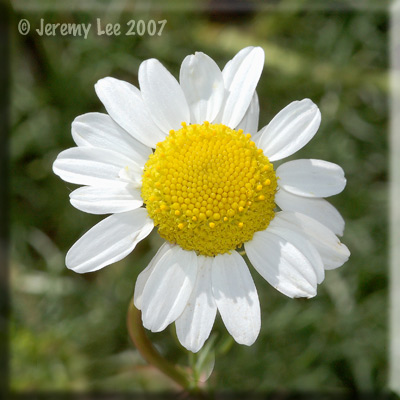
 |
|
Scientific Classifications explained » Amphibians » Ants » Aphids » Bees » Beetles » Birds » Bugs » Butterflies » Caterpillars » Damselflies » Dragonflies » Earwigs » Flies » Frog/Leafhoppers » Fungi » Galls » Grasshoppers » Harvestmen » Hoverflies » Lacewings » Ladybirds » Leaf Mines » Lichens » Mammals » Millipedes » Mosses » Moths » Sawflies » Slugs » Snails » Spiders » Trees & Shrubs » Wasps » Wild Flowers » Woodlice » Postboxes |
UK Nature > Wild Flowers > White Wild Flowers > Tripleurospermum maritimum

Scientific Name: Tripleurospermum maritimum Common Name: Sea Mayweed Tripleurospermum maritimum, more commonly known as Sea Mayweed, belongs to a confusing group of plants. Some, such as Pineapple weed (Matricaria discoidea) have a distinctive fruity smell when bruised; others, such as this species, have none. Its white, daisy-like flower heads have white outer florets around a dense yellow disc. They usually appear between July and September and can reach up to 50 mm across. The stems of the plant are frequently tinged red towards the base. Unlike those of other members of the family, its seeds have no white parachute of fine hairs to aid wind distribution. The leaves are divided into narrow segments and are slightly succulent; as a result they can retain moisture and tolerate harsh coastal locations. Can be found flowering from July to September all round the UK coastline. |
|

https://www.uknature.co.uk is a website dedicated to showing the immense diversity of UK nature and wildlife. Our vast range of habitats, from lowland arable to snow covered mountains, from storm-ravaged coastlines to peaceful inland freshwater lakes and rivers, from dry, sandy heaths to deciduous and coniferous forests, all these habitats contribute to the abundance of UK nature. We have wild birds in huge numbers either residing or visiting our shores (597 recorded species as at July 2013) and we must also not forget the humble back garden with its grass lawns, flower beds filled with nectar rich flowers, shrubs and trees, all designed to attract huge numbers of insects such as bees, moths, butterflies and hoverflies; and finally the small ponds which provide safe havens for frogs, toads, newts and even slow worms and grass snakes. www.uknature.co.uk is the showcase for my personal passion, photographing uknature in all its glory. I sincerely hope you all enjoy the fruits of my labours. This site and all images contained therein is © Jeremy Lee 2004 - 2025. All Rights Reserved. Site design by Jeremy Lee. Site development & IT Support by Stuart Lee. |